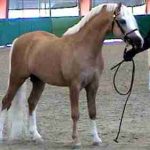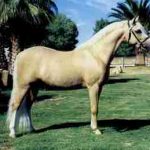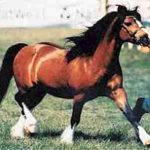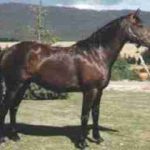The Welsh Cob, a breed originating from Wales, is known for its hardiness, intelligence, and versatility. With a rich history dating back centuries, this majestic horse has captured the hearts of equestrians worldwide. From its humble beginnings as a hardworking farm pony to its current prominence in various equestrian disciplines, the Welsh Cob has proven time and again that it can excel in any task it is given.
A Brief History of the Welsh Cob
The Welsh Cob’s roots can be traced back to ancient times, with evidence suggesting its existence before the Roman Empire. These hardy ponies roamed the hills and valleys of Wales, enduring harsh climates and sparse food sources. Their ability to thrive in such conditions contributed to the development of a breed with exceptional endurance, intelligence, and soundness.
Throughout history, the Welsh Cob has served many purposes. It was used as a cavalry horse, a pit pony in coal mines, and a reliable working animal on farms. The breed’s versatility and strength made it a valuable asset in various industries. However, it was not until the 20th century that the Welsh Pony and Cob Society was established, solidifying the breed’s recognition and providing a platform for its continued development.
The Four Sections of the Welsh Breed
The Welsh breed is divided into four sections, each with its own distinct characteristics and purposes. These sections are based on size and type, ensuring that there is a Welsh Cob suitable for every equestrian endeavor.
Section A: The Welsh Mountain Pony
 The Welsh Mountain Pony, also known as Section A, is the smallest of the four sections, with a height limit of 12.2 hands. These ponies have a long-standing presence in Wales, where they once roamed the hills freely. Despite their diminutive size, Welsh Mountain Ponies possess a remarkable combination of cleverness and kindness. They are ideal companions for children and excel in driving competitions.
The Welsh Mountain Pony, also known as Section A, is the smallest of the four sections, with a height limit of 12.2 hands. These ponies have a long-standing presence in Wales, where they once roamed the hills freely. Despite their diminutive size, Welsh Mountain Ponies possess a remarkable combination of cleverness and kindness. They are ideal companions for children and excel in driving competitions.
Section B: The Welsh Pony
 The Welsh Pony, or Section B, is slightly taller than the Welsh Mountain Pony, with a height limit of 14.2 hands. This section was developed to meet the demand for a larger pony while retaining the qualities for which the Welsh breed is renowned. Section B ponies are known for their versatility and exceptional performance in various disciplines. They make excellent mounts for older children and small adults, often serving as the next step after outgrowing a Welsh Mountain Pony.
The Welsh Pony, or Section B, is slightly taller than the Welsh Mountain Pony, with a height limit of 14.2 hands. This section was developed to meet the demand for a larger pony while retaining the qualities for which the Welsh breed is renowned. Section B ponies are known for their versatility and exceptional performance in various disciplines. They make excellent mounts for older children and small adults, often serving as the next step after outgrowing a Welsh Mountain Pony.
Section C: The Welsh Pony of Cob Type
 The Welsh Pony of Cob Type, or Section C, bridges the gap between ponies and cobs. With a height limit of 13.2 hands, Section C ponies are smaller than their Section D counterparts but possess the same attributes of strength and substance. They exhibit a great deal of pony quality, particularly in their facial features, while still maintaining the versatility and athleticism of the Welsh breed. Section C ponies excel in driving, jumping, and various other disciplines.
The Welsh Pony of Cob Type, or Section C, bridges the gap between ponies and cobs. With a height limit of 13.2 hands, Section C ponies are smaller than their Section D counterparts but possess the same attributes of strength and substance. They exhibit a great deal of pony quality, particularly in their facial features, while still maintaining the versatility and athleticism of the Welsh breed. Section C ponies excel in driving, jumping, and various other disciplines.
Section D: The Welsh Cob
 The Welsh Cob, the largest of the four sections, has no upper height limit and is suitable for adult horse riding. These majestic animals embody power, athleticism, and beauty. Welsh Cobs are renowned for their versatility, excelling in dressage, eventing, and driving. Their unique temperament, characterized by curiosity, kindness, and trainability, endears them to enthusiasts around the world. The Welsh Cob’s bold movement and impressive trot make it a remarkable sight to behold.
The Welsh Cob, the largest of the four sections, has no upper height limit and is suitable for adult horse riding. These majestic animals embody power, athleticism, and beauty. Welsh Cobs are renowned for their versatility, excelling in dressage, eventing, and driving. Their unique temperament, characterized by curiosity, kindness, and trainability, endears them to enthusiasts around the world. The Welsh Cob’s bold movement and impressive trot make it a remarkable sight to behold.
The Welsh Cob’s Influence and Popularity
The influence of the Welsh Cob extends far beyond its native Wales. This breed has made a significant impact on the development of other horse and pony breeds, both in Britain and the United States. Its hardiness, intelligence, and versatility have been sought after by breeders looking to enhance the qualities of their own stock.
In the United States, the Welsh Pony and Cob Society of America was established in 1906 to promote the breed and maintain a registry for Welsh ponies and cobs. Over the years, the breed’s popularity has grown exponentially, with thousands of registered Welsh ponies and cobs in the country. They can be found in every state, participating in various equestrian disciplines and delighting riders of all ages.
The Versatility of the Welsh Cob
The Welsh Cob’s versatility is one of its most remarkable attributes. Whether in the show ring, on the trails, or in the field, these horses can adapt to any task with ease. Their friendly personalities, even temperaments, and intelligence make them a joy to work with and train.
In equestrian competitive disciplines, Welsh ponies and cobs have excelled in a wide range of events. They have proven their prowess in showing, jumping, dressage, combined training, and driving. Their natural athleticism, coupled with their strong work ethic, allows them to thrive in any discipline they are introduced to.
Furthermore, Welsh ponies and cobs are cherished as leisure riding companions. Their steady gaits and gentle nature make them ideal mounts for riders of all skill levels. Whether embarking on a relaxing trail ride or honing their skills in the arena, equestrians can trust the Welsh Cob to provide a safe and enjoyable experience.
Caring for a Welsh Cob
Caring for a Welsh Cob involves providing them with proper nutrition, regular grooming, and a suitable living environment. These horses are hardy by nature, but attention must be given to their dietary needs to avoid conditions such as laminitis. Monitoring their sugar and carbohydrate intake and providing quality forage and feed is essential for their well-being.
Regular grooming is necessary to maintain the Welsh Cob’s beautiful appearance. Brushing their coat, mane, and tail helps keep their skin and hair healthy. Attention should also be given to their feathering, ensuring it remains clean and free from any skin conditions.
Adequate exercise and turnout are essential for the Welsh Cob’s physical and mental well-being. Providing them with ample space to move and graze allows them to thrive and exhibit their natural behaviors.
The Future of the Welsh Cob
The Welsh Cob’s future looks promising as its popularity continues to grow. Its exceptional qualities, combined with its versatility and adaptability, make it a breed that appeals to a wide range of equestrians. From children seeking their first pony to seasoned riders looking for a competitive mount, the Welsh Cob offers endless possibilities.
As the breed continues to flourish, breeders and enthusiasts alike will strive to preserve the Welsh Cob’s unique characteristics while further enhancing its performance capabilities. The Welsh Pony and Cob societies in various countries will play a vital role in promoting and preserving the breed’s integrity and ensuring its continued success.
In Conclusion
The Welsh Cob, with its rich history, remarkable versatility, and captivating presence, stands as a testament to the enduring spirit of the Welsh breed. From its humble beginnings as a hardworking farm pony to its current prominence in various equestrian disciplines, the Welsh Cob has proven time and again that it is a breed to be admired and cherished. Whether as a trusted companion on leisurely rides or a competitive partner in the show ring, the Welsh Cob continues to capture the hearts of equestrians worldwide.